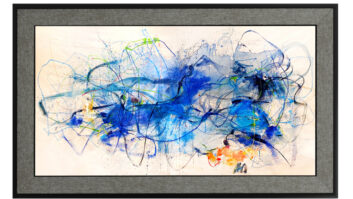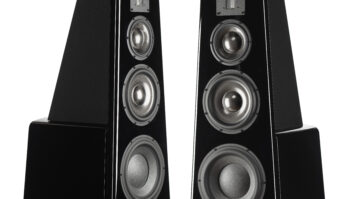Component-audio sales had a great fall in 2003, but audio suppliers and retailers are picking up the pieces and putting them back together again in a way that the king’s men couldn’t.
Retailers are merchandising component audio more aggressively and integrating audio components into their video displays to goose up sales. Suppliers are delivering more products that integrate easily with other home theater devices and with a home’s cosmetics. New video-friendly products complement flat-panel TV cosmetics or enhance video performance.
Although a fairy-tale ending might not be in the industry’s future, the outlook isn’t as grim as it used to be, according to a panel of key industry players selected by TWICE to debate the industry’s outlook. Questions were e-mailed to the marketing executives, who offered these responses:
COMPONENTS GOT IT GOING ON
TWICE:Factory-level sales of home audio components turned around in 2004 after a disastrous 2003. Why?
Gina Harman, Harman Consumer Group: I am certain it is a result of retailers paying much more attention to this absolutely necessary category. The margin erosion that results from selling mostly video products leaves a severe imbalance in profitability. Good audio is not only necessary for the consumer — in order to realize the full experience offered by today’s multichannel audio formats — it’s necessary for dealers to remain in business. Home entertainment is about selling the complete experience, not just some of the parts without the whole.
Jacobs: I think the most important driver of increased audio sales during 2004 is that retailers were forced to focus on audio again.
Sandy Gross, Directed Electronics: There has been a major focus on the part of retailers to recharge their sales of audio, especially higher-quality component audio, and it is beginning to get traction. Also, the fact that prices of plasma and other desirable high-tech TVs (like DLP) have dropped clearly frees up more of the consumers’ budgets to buy audio with.
Dean Tassio, Polk Audio: We suggest that dealers more aggressively integrate component audio with their video displays, and vice versa, to benefit from cross-pollination.
The dealers we know who have stayed focused on component audio merchandising have held their own in regards to component sales. More telling is dealers who took their eyes off the component ball and jumped too strongly into HTiB. They have seen the greatest declines in component sales with a subsequent drop in average ticket value and profitability.
Phil Abram, Sony Electronics: A majority of the turnaround was due to activity in the first half, when some manufacturers cleared inventory and transitioned to new models. During this time, there were higher units shipped but at lower ASPs. Also, the sell-in outpaced the sell-through for the first half, leaving some retailers heavy with inventory.
TWICE:Which component segments are posting healthy growth?
Harman: Our mid- to high-end products were gaining strength during 2004. The customer who is offered a credible demo and a suitable answer to their system needs is stepping up to buy better audio components.
Our products are at the top of what most of our distribution carries and therefore have fared much better, in most cases, than products that occupy lower price points and position.
Receivers above $500 and speaker packages above $500 are gathering strength through traditional distribution. We are also seeing more momentum in $5,000-$15,000 audio systems at specialty- and custom-focused retailers.
We also continue to enjoy growth at the very premium end of the market in systems, such as JBL Synthesis systems, in the $30,000-$100,000 range. We expect these trends to continue through 2005.
David Kroll, Boston Acoustics:We’re seeing significant growth in the in-wall and in-ceiling speaker categories and tremendous growth in the on-wall speaker category. This is partly because consumers are looking for lifestyle products that look attractive next to flat-panel TVs. These TVs embody new technology but also a new design esthetic that reflects something we’ve always believed in. As consumer tastes have changed, Boston Acoustics has adapted the form factor of our products to address those changes.
Abram: In receivers, the overall price band structure of $500 and down has not changed year over year, representing 63 percent of dollar volume. The largest growth, however, has taken place in the $600-$800 price point. Recently, this price band has been expanding in larger retail accounts, where traditionally higher price points have not been found. In the past, the $600-$800 price band has been dominated by the specialty audio or upper-end retail accounts.
The speaker business was down slightly in 2004 vs. 2003. Growth in loudspeakers has been primarily dominated by on-wall and in-wall products. The traditional home speaker business has been driven by aggressive promotional activities and an increase in large mass-channel retail merchants.
In 2005, the segments primarily will be stable in comparison to 2004. Growth areas within receivers will be primarily at higher price points with such video- for-audio features as video upconversion and HD switching. The speaker business should remain relatively calm, with some growth in packages that match displays.
T. Paul Jacobs, Klipsch Audio Technologies: Receivers, speakers, and electronics separates will see growth depending on the price points they occupy. Lower price points should see healthy growth. Mid-priced products should be stable to up, and certain higher-priced products could see significant growth in 2004.
HOT RECEIVER FEATURES
TWICE:What technologies or features are driving component sales?
Harman: There is little doubt that component audio sales are driven by sales of video display devices, with audio components as an add-on to the video purchase. However, consumers at all levels want to seamlessly blend picture and sound in their home entertainment systems. And music is still a fundamental part of people’s lives. These factors are leading the receiver to quickly become the central hub of today’s (and tomorrow’s) home entertainment system.
To this end, more and more audio/video receivers are including features that enhance video performance and make easier the integration of set-top boxes, DVD players/recorders, and other related devices. We are even seeing receivers that combine control and management systems that can replace set-top boxes. Though these receivers are often clumsy in their approach to audio and video performance, and to the user interface, they nevertheless speak to the customer’s desire to eliminate boxes.
We are introducing a receiver-based home entertainment network, Audioaccess’s W.H.E.N., in the spring of 2005, and it will offer high performance, ease of installation, and associated “killer apps” that make it the perfect whole-house entertainment system for builders and their customers.
Kroll: The features driving component audio sales are those that make audio systems easier for consumers to operate and enjoy. Whether new technology becomes a tool for custom installers to help integrate components into a simple control system, or whether new technology makes products easier for consumers to understand and use, products built with this mindset will achieve the greatest acceptance.
Consumers are tired of buying technology for technology’s sake only to find they can’t operate and enjoy the products once they get them home. In 2005, successful products will utilize technology that truly simplifies the home theater experience — technology such as our UniView, which automatically ensures the best possible picture quality no matter where the video signal is coming from.
Tassio: Any new technology or feature set that adds real value to the end user is good for the industry and may help boost component sales to some degree. The danger is that if new technologies are too confusing or hard to use, they may actually backfire and drive consumers toward simpler, less intimidating HTiB systems. Our industry has a bad habit of loading on more and more functionality and features without adequate regard for ease-of-use.
One technology that Polk Audio is championing in the coming year is IP-addressable audio distribution, such as the DigiLinx system from NetStreams. This is a technology that directly addresses the ease-of-use issue, at least in whole-house systems, and at the same time offers dramatically improved performance and ease-of-installation benefits for the installing dealer.
A revival of the music business is also a major key to boosting component audio sales. Where is this generation’s Elvis or Beatles? How can anyone care about high quality sound if they don’t care about the music?
Abram: Video features are an important area of focus for the A/V receiver. With all of the changes in video standards, the customer is looking for a product that can ensure some form of device-to-device compatibility. Compatibility may be defined as upconversion that allows for a single connection point to the TV or as an interface that adds value or improves the signal. Consumers see receivers as not only a switching device but also a switching device that adds value to the connection it makes.
Receivers with custom-install features are an expanding area. This growth is not driven by the end users’ demand for custom-install features per se; rather, the focus is on applications such as audio in multiple places in the home. The installer is the one who recognizes the need to have an A/V receiver with a robust interface that is easy-to-use and achieves a high level of integration right out of the box.
“Robust interface” means compatibility with other manufacturers’ integration equipment no matter how simple or complex the solution is.
Distributed-audio receivers are also an area of expansion in traditional as well as nontraditional channels. Recognizable brands are starting to enter this arena. That adds a certain degree of acceptance among consumers. It also means that a fully integrated solution, complete with display product, sources and signal, can now be linked in a fashion that is seamless to the consumer. This type of solution is valuable in the nontraditional channels, such as builders and designers.
Traditional retailers have been able to piece together solutions from various manufacturers to create functional multizone systems. Recognizable brands entering traditional retail allows a one-box approach to multizone, with source to output to zone fully covered.
Jacobs: Networked audio products will grow because prices have come down, and early adopters continue to have significant interest. Other growth areas include products that improve quality and become easier to use.
HOT SPEAKER FEATURES
Abrams:In speakers, flat is where it is at. With the growth of flat-panel and micro displays, the traditional loudspeaker is beginning to look dated. Speakers should complement the design trends in the video world. “Audio for video” continues to be a major driver in the business.
CompanyName New designs are flexible and offer performance and cosmetics to match these new displays. We must recognize the element of consumer electronics as furnishings or elements of a home’s interior design.
Jacobs: Custom-installed products, particularly those with a retrofit focus, are growing. New speaker formats will grow, but they will likely cannibalize traditional products and not necessarily drive additional sales.
Gross: Speakers that go with flat-panel TVs are obviously hot. But more importantly, high style has become as important as high performance in upscale speakers. We have seen a tremendous acceptance of speakers that are not “invisible” but rather are reasonably sized and beautifully designed.
Suppliers have been replacing big ugly boxes with beautiful boxes whose styling doesn’t put off consumers, particularly women. With big ugly boxes, dealers got the perception that they couldn’t sell upscale component speakers, but you can if the styling is right.
Clearly the greatest challenge facing the component-audio industry is making upscale audio a key part, if not absolutely a requirement, of an upscale lifestyle. The industry has really failed at this, but it does present tremendous opportunities for expansion and growth in the future. Upscale homeowners all have fancy refrigerators, fancy stoves and fancy lighting, and are acquiring fancy expensive TVs (not to mention automobiles and watches). This is all de rigueur for their lifestyle. Now it is time to make audio as important as a kitchen sink — something that people want to show off to their friends rather than hide.
Kroll: Recent changes in audio sales are due to two factors. First, retailers are redirecting their merchandising to provide better lifestyle audio presentations, and they are directing their sales forces to make those presentations. Second, manufacturers are making more products that look good with today’s flat-panel TVs.
THE PROBLEM WITH PLASMA
TWICE:Are declining flat-panel and microdisplay prices freeing up money for component-audio purchases?
Harman: I believe the potential has always been there to successfully sell component audio in addition to video displays. I don’t think the pricing of plasma displays was the issue behind component audio’s decline, although it might have contributed. I believe retailers lost sight of the fact that what we deliver is something that people desire and aspire to. “It’s the experience, stupid.” Telling the story that audio is critical to the performance of a home theater system allows a customer to choose the best combination of audio and video.
As the price of flat-panel displays comes down, a larger segment of the market will be attracted to complete audio and video systems, and audio will be the beneficiary of those numbers.
Kroll: Too many retailers are not doing a good job of selling lifestyle audio products that complement the flat-panel TVs that so many consumers are buying. As a result, consumers are hooking up new, contemporary-looking TVs to yesterday’s audio packages. Sometimes this is due to merchandising in which audio and video demos are not well-integrated. Other times, it’s because retail salespeople in a down economy are so happy to sell a TV that they worry that an enthusiastic audio presentation might compromise the entire deal. They settle for something instead of trying for more.
The lower retail prices of flat-panel TVs are not, by themselves, prompting consumers to spend more on audio. The lower prices are attracting consumers with less disposable income to spend on audio. These are the customers who had to wait until TV prices dropped.
Tassio:As long as component audio is under-merchandised, under-advertised and under-demonstrated, falling TV prices will have no effect on component audio sales.
Abram: There is still a drive by consumers to spend as much as they can on the video display. Lower prices mean they can get a larger size or move up from CRT-based solutions. For the retail associate, it is easier to get $500 more on a sales ticket by stepping the customer up on the screen rather than bringing audio into the sale.
Jacobs: Falling plasma prices appear to be helping audio, but there is no real evidence plasma was hurting audio sales to begin with. I’ve always felt it was an excuse for poor execution.
Gross: Absolutely more money is now going into audio now that the prices of the TVs have dropped.













